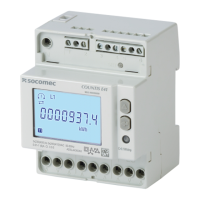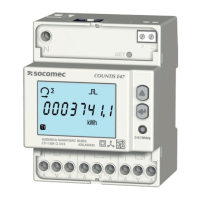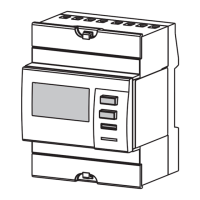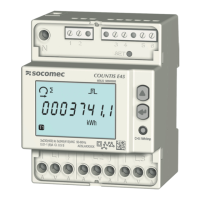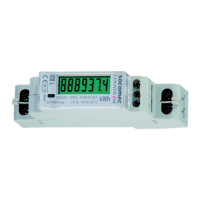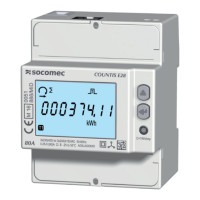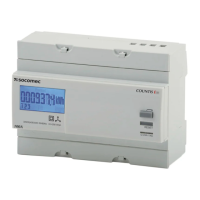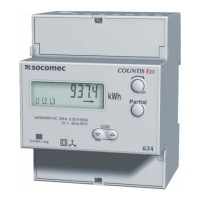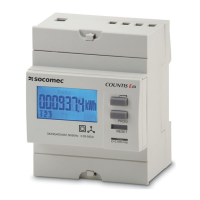
Do you have a question about the socomec COUNTIS E43 and is the answer not in the manual?
| Type | Energy meter |
|---|---|
| Display | LCD |
| Output type | Pulse output |
| Mounting type | DIN rail |
| Number of phases | 3 |
| Frequency | 50/60 Hz |
| Measurement | Active Energy, Reactive Energy |
| Current Range | 0.5 A to 5 A |
| Accuracy Class | Class 1 |
| Communication | Modbus |
| Technology | Digital |
Precautions to prevent death or serious injury from electrical hazards.
Precautions to prevent death or serious injury from electrical hazards.
Steps to ensure the unit operates correctly and avoid damage.
Guidelines on assembly, connection, and use according to standards.
Verify packaging condition, unit integrity, reference, and included items.
Description of the COUNTIS E43/E44 as modular energy meters for three-phase networks.
Lists functions like energy measurement, tariff management, and communication.
Identifies buttons, display, and terminals on the device's front panel.
Details the meaning of symbols and indicators on the device's LCD screen.
Provides the physical dimensions of the COUNTIS E43/E44 in inches and millimeters.
Details realtime and logged electrical values, symbols, units, and display/communication availability.
Provides the formulas for calculating energy balance in kWh and kvarh.
Safety advice and environmental considerations for installing the device.
Instructions for mounting the COUNTIS E43/E44 on a 35-mm DIN rail.
Shows terminal connections for power and current inputs with cable specifications.
Diagram and explanation for connecting to three-phase networks with neutral and CTs.
Covers network type, terminal covers, program button locking, and RS485 communication.
Explains Modbus communication via RS485 series link and standard connection configurations.
Specifies cable type, repeater usage, and termination resistors for RS485 connections.
Details the Modbus RTU master/slave structure, frame format, and inter-character time.
Indicates that communication tables and notes are available on the Socomec website.
Guide to navigating menus for changing communication settings and other parameters.
Explains how to access programming mode and select tariff management via COM or DiG inputs.
Lists the available parameters within the SETUP 2 menu, including communication settings and resets.
Details configuration for Communication Address, Speed, Parity, Stop Bit, and Energy Reset.
Step-by-step guide to setting the Modbus communication address on the device.
Explains how to view imported/exported active, reactive, and inductive/capacitive energy per tariff.
Details how to view total imported/exported active, reactive, and apparent energy.
Shows how to view partial energy readings and energy balance for active and reactive energy.
Explains how to view realtime active power, apparent power, reactive power, voltage, current, and power factor.
Details how to view firmware versions, checksums, communication port, and CT primary value.
Details imported/exported active, inductive reactive, and capacitive reactive energy for Tariff 1.
Details imported/exported active, inductive reactive, and capacitive reactive energy for Tariff 2.
Details imported/exported active, inductive reactive, and capacitive reactive energy for Tariff 3.
Details imported/exported active, inductive reactive, and capacitive reactive energy for Tariff 4.
Shows total imported/exported active, reactive, and apparent energy across all phases.
Displays partial imported/exported active, apparent, and reactive energy, plus energy balances.
Instructions on how to start the partial energy meter function.
Instructions on how to stop the partial energy meter function.
Procedure for resetting the partial energy meter to zero.
Details realtime active power, apparent power, reactive power, voltage, current, and power factor.
Displays metrological and non-metrological firmware versions, checksums, and CT primary value.
Explains the exclamation point symbol indicating missing phases.
Describes symbols indicating 123 or 132 phase sequences.
Indicates a malfunction requiring meter replacement, shown by an 'ERR' message.
Provides solutions for common problems like device not working or phases not shown.
Lists compliance directives, frequency, power supply, and dissipated power.
Details connectivity, energy reading storage, and tariff identification.
Specifies current transformer type, burden, startup current, and min/max current.
Defines voltage and current limits for continuous and momentary operation.
Details consumption and permanent/momentary maximum voltage.
Specifies the frequency measurement range.
Confirms active, reactive, total/partial readings, MID metering, and resolution.
Details accuracy classes for active and reactive energy.
Specifies tariff management options, number of tariffs, and input types.
Details pulse value and color of the metrological LED.
Describes pulse output type, pulse weight settings based on CT ratio.
Details display type, refresh time, backlight, and ranges for various measurements.
Lists RS485 details: protocol, baudrate, insulation, and unity of load.
Indicates energy registers are stored in FRAM memory.
Specifies mechanical, electromagnetic environments, operating/storage temperatures, and humidity.
Details dimensions, mounting type, connection capacity, protection index, insulation class, and weight.
Defines common abbreviations used in the manual, such as menu codes and parameters.
